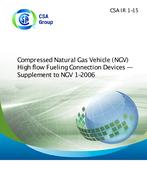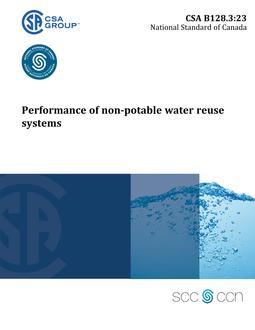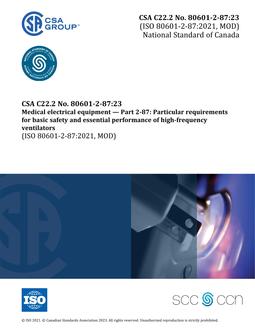
CSA IR-1-15
Preface
This Interim Requirement (IR) is being developed for agencies in North America to use for examination, testing and certification of compressed Natural Gas Vehicle (NGV) fueling nozzles and receptacles only. As such, the scope refers to nozzles and receptacles used in the NGV fueling system, and not to the system. The American Gas Association (A.G.A.) Requirements for Natural Gas Refueling Connection Devices (No. 1-90) and Canadian Gas Association Certification Requirement for NGV Nozzles and Receptacles (Draft CR 90-005) provided a basis for this Interim Requirement. A nozzle certified to this Interim Requirement will be functionally compatible from a safety and performance perspective with all listed receptacles of compatible profile and system pressure. Similarly, a receptacle certified to this Interim Requirement will be functionally compatible from a safety and performance perspective with all listed nozzles of compatible profile and system pressure. Whereas there may be a multitude of nozzles and receptacles by a host of manufacturers, all of which for safety reasons must be compatible with each other, a series of “standard” receptacle profiles have been specified. These standard profiles incorporate the mandated design specifications (mating materials, geometry and tolerances) which must be utilized in the certification of a submitted nozzle or receptacle. The design shall be unique and not currently in commercial use and shall only be used for compressed natural gas. Currently, three vehicle system service pressures may be operated in North America; 16 500 kPa (2400 psi), 20 700 kPa (3000 psi) and 24 800 kPa (3600 psi). Consequently, the nozzle and receptacle must be designed in a manner which will prevent a vehicle from being fueled by a dispenser station with a service pressure higher than the vehicle. However, it is desirable that a vehicle can be fueled by a dispenser station with a service pressure lower than the vehicle. This issue is addressed in the geometry of the nozzle and receptacle. All nozzles and receptacles shall be designed to have a service pressure of either 16 500 kPa (2400 psi), 20 700 kPa (3000 psi) or 24 800 kPa (3600 psi), as applicable. The construction and performance of nozzles and receptacles are based on the observation that three main parameters affect user safety and system compatibility. 1. Service Pressure. Currently, three vehicle system service pressures may be operated in North America; 16 500 kPa (2400 psi), 20 700 kPa (3000 psi) and 24 800 kPa (3600 psi). Consequently, the nozzle and receptacle must be designed in a manner which will prevent a vehicle from being fueled by a dispenser station with a service pressure higher than the vehicle. However, it is desirable that a vehicle can be fueled by a dispenser station with a service pressure lower than the vehicle. This issue is addressed in the geometry of the nozzle and receptacle. All nozzles and receptacles shall be designed to have a service pressure of either 16 500 kPa (2400 psi), 20 700 kPa (3000 psi) or 24 800 kPa (3600 psi), as applicable. 2. Disconnect Venting. Nozzles transferring fuel under high pressure must be fully and safely depressurized prior to being disconnected from the receptacle. This Interim Requirement addresses three types of nozzles, described as follows:
- Type 1 Nozzle – With a Type 1 Nozzle, the vent valve operating mechanism is integral to the nozzle. The term “integral” means that a single operation of a lever or operating mechanism first safely vents the gas trapped between the receptacle check valve and the nozzle inlet valve, and then safely disconnects the nozzle from the receptacle. This type nozzle is primarily intended but not restricted to use at public fill stations. Type 2 Nozzle – With a Type 2 nozzle, the vent valve operating mechanism is external to the nozzle. Venting is required prior to disconnection of this type of nozzle. This type of nozzle is intended to be used by trained operators only. Type 3 Nozzle – With a Type 3 nozzle, the fueling hose is automatically depressurized [typically below 340 kPa (50 psi)] at dispenser shutdown. The nozzle may vent low pressure gas between the receptacle check valve and the nozzle inlet valve coincident with the disconnection of the nozzle. This type of nozzle is intended to be used by trained operators only.
3. Design Life. Frequency of use is the final parameter to be considered. Since frequency of use will differ with the nozzle/receptacle application (i.e., public sector, fleet employee and residential), all receptacles will be tested at 10,000 connect/disconnect cycles for compliance with this Interim Requirement. In addition, all nozzles shall be tested according to the following frequency use classifications, as applicable:
- Class A Nozzle – This class specifies high frequency use, with a cycle life of 100,000. This equates to approximately 100 fills per day for 3 years. Class B Nozzle – This class specifies medium frequency use, with a cycle life of 20,000 cycles. This equates to approximately 10 fills per day for 5 years.
Scope
1.1.1 This Interim Requirement applies to newly produced compressed Natural Gas Vehicle (NGV) fueling connection devices, hereinafter referred to as devices, constructed entirely of new, unused parts and materials. NGV fueling connection devices shall consist of the following components, as applicable: 1. Receptacle and protective cap (mounted on vehicle) (see Clause 1.5, Receptacles); 2. Nozzle (see Clause 1.3, Nozzles); and/or 3. Three-way valve (external to nozzle and mounted in the fuel dispenser system) (see Clause 1.6, Three-Way Valve). 1.1.2 This Interim Requirement supplements CSA Group?s American National Standard/CSA Standard for Compressed Natural Gas Vehicle (NGV) Fueling Connection Devices NGV 1-2006. 1.1.3 This Interim Requirement applies to devices which have a service pressure of 24 800 kPa (3600 psi), hereinafter referred to in this Interim Requirement as the following (see Clause 1.9.1-c):
- “P30HD” – 20 700 kPa (3000 psi) “P36HD” – 24 800kPa (3600 psi)
1.1.4 This Interim Requirement applies to devices with standardized mating components (see Clauses 1.5.5, and 1.7, Interchangeability.) 1.1.5 This Interim Requirement applies to devices which (1) prevent natural gas vehicles from being fueled by dispenser stations with service pressures higher than the vehicle, and (2) allow natural gas vehicles to be fueled by dispenser stations with service pressures equal to or lower than the vehicle fuel system service pressure. 1.1.6 All dimensions used in this Interim Requirement are in metric units [International System of Units (SI)], unless otherwise specified. If a value for measurement, as given in this Interim Requirement, is followed by an equivalent value in other units, the first stated value is to be regarded as the specification. 1.1.7 Exhibit A contains a list of standards specifically referenced in this Interim Requirement, and sources from which these referenced standards may be obtained. 1.1.8 For the purposes of this Interim Requirement, compressed natural gas shall comply with the specifications under “Gas Quality”, in the Standard for Compressed Natural Gas (CNG) Vehicular Fuel Systems, ANSI/NFPA 52. 1.1.9 All references to “psi or kPa” throughout this Interim Requirement are to be considered gage pressures unless otherwise specified.
Product Details
- Published:
- 08/26/2015
- Number of Pages:
- 45
- File Size:
- 1 file , 3.4 MB
- Product Code(s):
- 2424603, 2424603, 2424603


